1. Literary Social Experiment
Various organizations are competing to ensure that within the next two decades humans will become an interplanetary species by establishing a presence on Mars. Elon Musk’s SpaceX is among the most visible competitors working to achieve this goal, as Musk argues that either “we stay on Earth forever and then there will be an inevitable extinction event,” or “become a spacefaring civilization, and a multi-planetary species.”1
The first two seasons of the television series Mars (2016–present), produced by National Geographic, can be read as a docu-fiction infomercial for Musk’s company. Its documentary component shows SpaceX’s present-day tests of reusable rockets, aiming to enable travels back and forth to Mars, while its science-fictional Hollywood-styled segments visualize Musk’s year-by-year plan to build a sustainable human presence on the planet.
SpaceX imagines that humanity’s transition from planetary to interplanetary species will transpire through extractivist pursuits. The planned Martian settlement includes spaces to sleep, laboratories for studies and experiments, agricultural areas to grow plants, and in time, a bar. The corporate components of the mission, intended to finance its scientific pursuits, propose to mine the planet’s resources: first water, and in the long term nickel, copper, iron, titanium, and platinum. But the plan includes no physical political or cultural infrastructures to speak of, or any meaningful discourse on future forms of governance: there is no parliament or space of common decision-making, or cultural spaces (besides the bar) for that matter. These absences are indicative of a particular state idea, namely that of the neocolonial, extractivist, corporatist state, following Bob Jessop’s notion of the “state idea” as a fourth component to Max Weber’s three-elements approach to state theory.2
This state idea is shared by figures such as Jeff Bezos, founder of the trillion-dollar company Amazon, whose business model is based on structural tax evasion and the extreme exploitation and precaritization of its workers. This has enriched Bezos to such a degree that he has been able to create his own company for space exploration, Blue Origin.
As a radical historical counterpoint to the way this state idea has come to structure our interplanetary future imaginary, I propose to return to the Martian vision put forth by Russian philosopher and revolutionary Alexander Bogdanov, set out in his 1908 novel Red Star. In Bogdanov’s book, comrade Leonid is visited by a Martian revolutionary just after the failed Moscow uprising of 1905. Leonid then travels to the red planet and discovers that on Mars the communist revolution has already taken place. Factory labor is voluntary and workers do not commit to one craft or another, but circulate continuously between occupations; in the children’s colony, different generations of young comrades educate one another and live collectively without their biological parents; and public monuments and art displays are conceived of as collective achievements rather than individual masterpieces: “In pre-socialist times the Martians erected monuments to their great people. Now they dedicate them only to important events.”3 Despite these emancipatory egalitarian achievements, Leonid discovers that Martian communist society harbors a great dilemma. Due to overpopulation and excessive resource extraction, a debate has ensued about whether communist Mars should colonize capitalist earth.4
Bogdanov’s interplanetary speculations explore the potentials of communist society in terms of a fundamental reorganization of labor as well as social, cultural, and sex and gender relations. He even goes as far as to script the ecological dilemmas inherent to mass industrialization that we are confronted with today. In contrast, contemporary neocolonial, extractivist, and corporatist interplanetary objectives are blatantly clear, and as space law was drafted for and by nation-states, multinational companies like SpaceX and Blue Origin face only limited juridical hurdles in their objectives.5 Today, the agents of this state idea speak shamelessly of Mars “colonization,” and the humans engaged in these missions as “pioneers” to terraform a “dead planet.” Such discourse reproduces and exports the worst of colonial and imperialist histories, mimicking the claim of “terra nullius” (nobody’s land) that has been used to legitimize the erasure of indigenous histories and lives.6
How can our heritage of emancipatory science and cosmic fictions counter the dominance of this trajectory of interplanetarianism—one that now also includes Trump’s declaration of a new “Space Force” as a sixth branch of government, essentially forging a form of space nationalism?7 While in a time of devastating ecological catastrophe it makes sense to claim “Earth First,” emancipatory science and cosmic fiction has always aimed to use interplanetary perspectives to enable new intra-planetary engagements. These are the very conditions and models through which we form a terrestrial community “bound to the earth and land.”8 The catastrophes about to be exported into outer space replicate earthbound exploitation, but in emancipatory science and cosmic fiction it works the other way around: interplanetary imaginaries become ways of expanding our understanding and practice of terrestrial life.
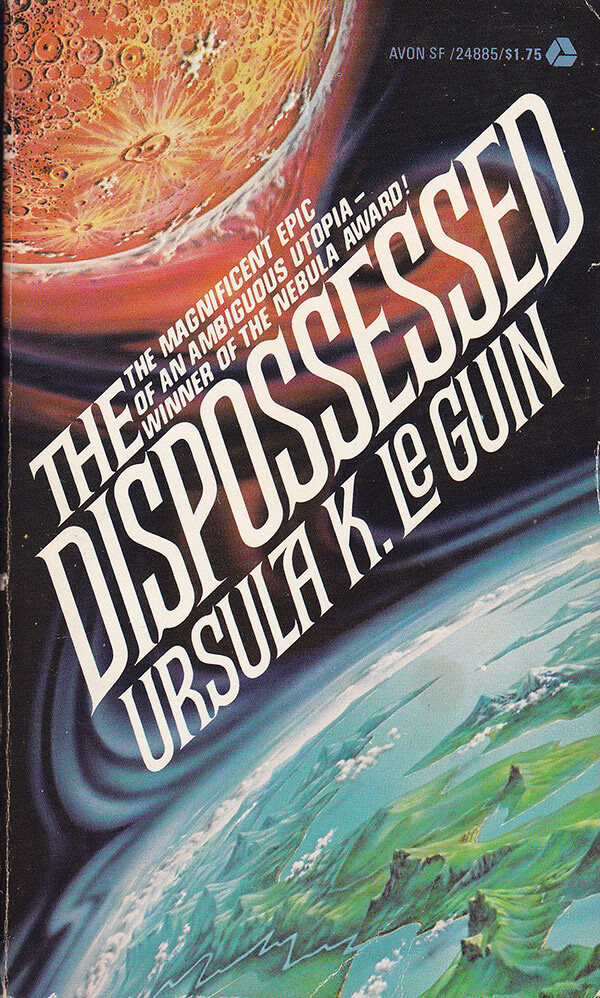

The cover of the first paperback edition of Ursula K. Le Guin’s The Dispossessed (1974) displays its ideological planetarium.
In her landmark 1974 novel from the Hainish Cycle titled The Dispossessed: An Ambiguous Utopia, Ursula K. Le Guin describes life on the anarcho-syndicalist planet Anarres. Similar to the Mars society portrayed in Red Star, on Anarres labor tasks are continuously rotated, but in this case among syndicates, as opposed to the centralized systems of communist Mars. Protagonist Shevek explains that on Anarres “we do not govern persons” but “administer production.”9 And while Anarres simultaneously operates as a mining colony for the capitalist-authoritarian planet Urras, it has nonetheless succeeded in eradicating what the anarcho-syndicalists term “egoizing terminology”: in language and daily practice, material, intellectual, and affective property has been eradicated. The notion of “dispossession” in the title has a liberatory significance—a “change of mentality,” as the Kurdish women’s movement phrases it—in which statelessness and being without property is the precondition for genuine freedom.10 As Shevek explains to protestors on the capitalist-authoritarian planet:
If it is Anarres you want, if it is the future you seek, then I tell you that you must come to it with empty hands. You must come to it alone, and naked, as the child comes into the world, into this future, without any past, without any property, wholly dependent on other people for his life … You cannot buy the revolution. You cannot make the revolution. You can only be the Revolution.11
In Le Guin’s novel, the idea of interplanetarianism presents a planetarium of ideologies.12 It allows her to speculatively test an anarcho-syndicalist model applied to an entire planet, rather than in autonomist zones as is presently possible on earth, for example in the courageous coalition of farmers, libertarian socialists, anarchists, and radical ecologists of the Zone à Défendre (ZAD) in Notre-Dame-des-Landes, France.13 By scaling autonomism to a planetary level, the outer consequences of its propositions and its contradictions are explored. As such, Le Guin’s novel is—similar to Bogdanov’s—a social experiment in literary form.
Now, in the face of the dominance of the corporatist state idea, the challenge is to translate these literary social experiments into new cultural narratives through which we can articulate our becoming interplanetary, and to create the material infrastructures that would enable new inter- and intra-planetary forms of living—forms of life.
2. The Art of Hyperempathy
Literary experimentation with the social dimensions of interplanetary life might have gained some of its most radical forms in the work of Octavia E. Butler. Throughout her various works, Butler insisted that human transformation would be interdependent with interplanetary cultural and biological mutation. In her Xenogenesis Trilogy (1987–89), this happens through the encounter of the human species with the “gene-trader” species Oankali, that can genetically mutate what it considers the “human contradiction,” namely the combination of “intelligence and hierarchical behavior.”14 As a result, new interdependent “construct” families emerge with both Oankali and human members, which the Otolith Group has described as “experiments in thought” that enable “alien intimacy.”15 In this literary social experiment, becoming interplanetary means becoming other-than-human in the first place. Undoing the human contradiction is the precondition for moving beyond earthbound existence: no space exploration before mutation!
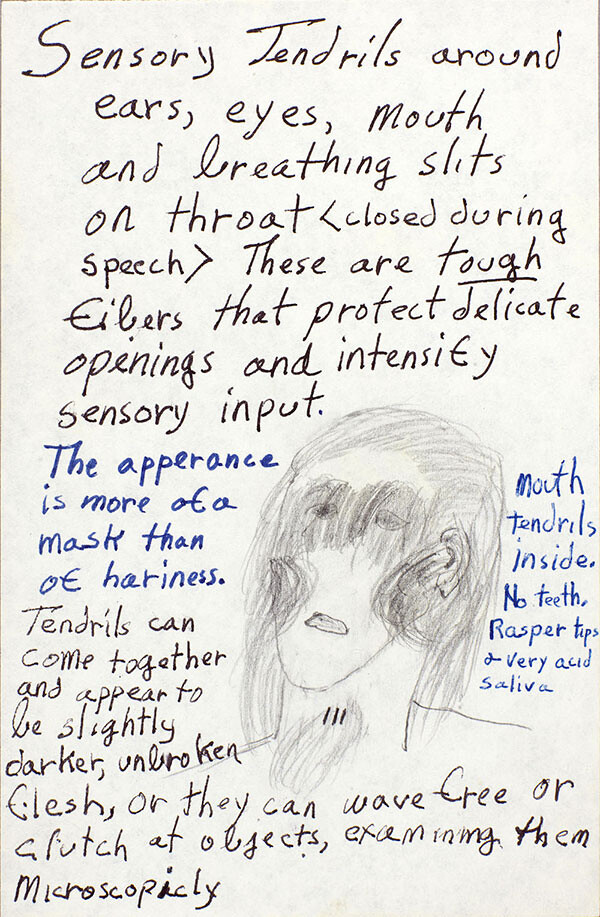

Octavia E. Butler, Notes on the Oankali, ca. 1985. The Huntington Library, Art Collections, and Botanical Gardens. Estate of Octavia E. Butler.
In Butler’s diptych Parable of the Sower (1993) and Parable of the Talents (1998), such a modification to counter the human contradiction emerges not as an interplanetary influence, but as a planetary affliction called “hyperempathy syndrome,” which brings one to feel the physical pain of others who are in direct proximity.16 We follow the main protagonist of the novel, hyperempath Lauren Olamina, as she attempts to build a new secular-religious “Earthseed” community in a future United States that is plagued by ecological collapse, corporate authoritarianism, and evangelical extremism. Despite utter planetary devastation and perpetual civil war, Olamina insists that her planned Earthseed communities are not to remain autonomist egalitarian islands, but must work towards a new form of planetary governance and, from that moment onwards, aim to transform humans into an interplanetary species to engage other “living worlds.”17 As Olamina notes in her book of scripture, Earthseed: The Book of the Living:
Earthseed is the dawning adulthood of the human species. It offers the only true immortality. It enables the seeds of the Earth to become the seeds of new life, new communities on new earths. The Destiny of Earthseed is to take root among the stars, and there, again, to grow, to learn, and to fly.18
What we encounter in Bogdanov, Le Guin, and Butler is the question of what conditions and models define our engagement with other living worlds, both interplanetary and terrestrial. A politics of hyperempathy, as Butler proposes in her literary social experiment, is inherently egalitarian: what I do to you I will feel equally myself. Muskian notions of the Mars “colony” and the human “pioneer,” which are agents of aggression, could then be rearticulated into hyperempathic models such as interplanetary cooperation and interplanetary guesting.19 The fact that Musk is not capable of recognizing Martian agency, simply because it does not mimic what he is willing to consider “life,” mirrors the undoing of our own terrestrial existence, given the similar negation of ancient ice caps and forests on earth. A politics of hyperempathy would not terraform the Other, but demand the transformation of the collective self to enable expanded terrestrial and interplanetary comradeship. As Shevek said, “You can only be the Revolution.”
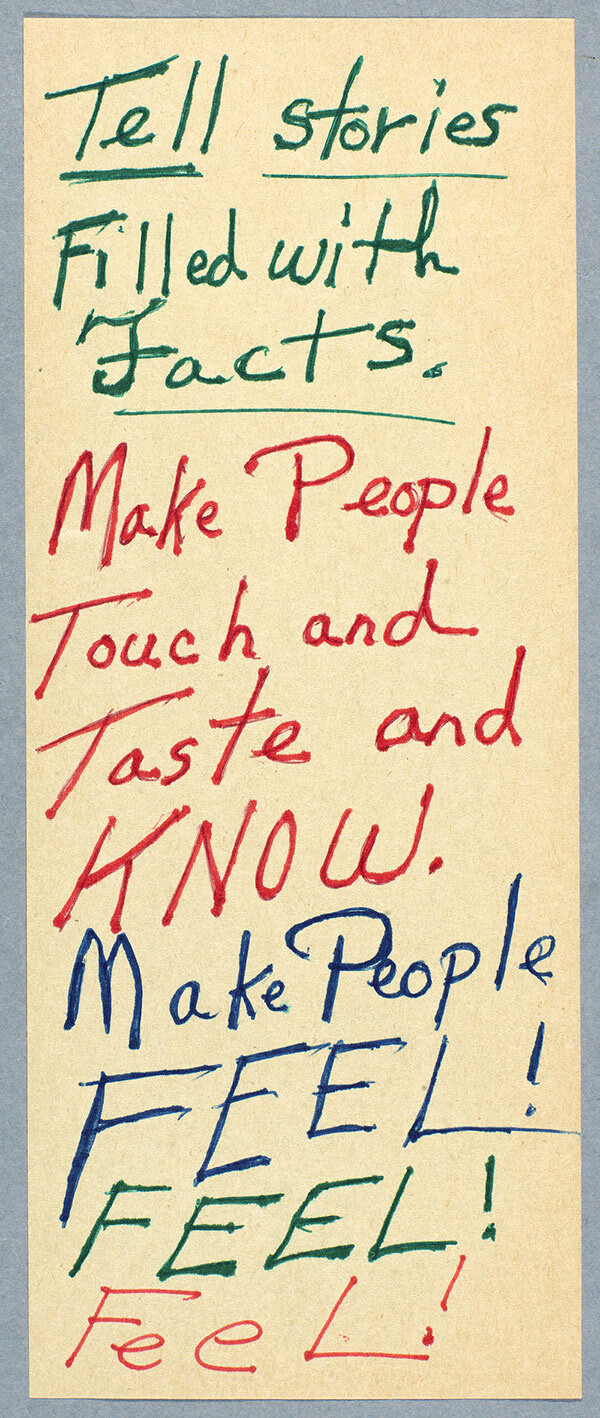

Octavia E. Butler’s notes on writing, ca. 1970–95: “Tell stories filled with facts …” The Huntington Library, Art Collections, and Botanical Gardens. Estate of Octavia E. Butler.
While Butler insisted, outside of her novels as well, that “the best thing we can do for the species is to go out into space” in order to “mature,” her work always starts with challenging our intra-planetary relationships.20 In other words, interplanetarianism as a field of emancipatory politics would only become possible through an enabling and deepening of intra-planetary relationships. And that means engaging hyperempathic assemblies—practices that Judith Butler has termed “performative assembly”—in which new “construct” families can emerge that counter the human-centric extractivist mentality.21
In Donna Haraway’s words, this demands a form of “sympoiesis,” meaning a practice of “making-with,” in accordance with her argument that “nothing is really autopoietic or self-organizing.”22 Rejecting the terms “Anthropocene” and “Capitalocene,” Haraway has proposed “Chthulucene” as a term for the geological era of “intra-active entities-in-assemblages—including the more-than-human, other-than-human, inhuman, and human-as-humus.”23 It is in such a multispecies intersectionality, Haraway argues, that one makes “kin” as “something other/more than entities tied by ancestry or genealogy.”24 But how, in a time that is beginning to meet the criteria of the uninhabitable world that Octavia Butler described so aptly in her Parable diptych, do we propagate such simultaneous inter- and intra-planetary assemblies? What, in other words, would be our art of hyperempathy? On this, Haraway notes:
I don’t work by simplification and I am rarely drawn by art that works by reduction. And I am a polemicist. An ideologue. I think doing really good propaganda is something we really got to figure out how to get better at. I’m really interested in propaganda as a form that need not be full of alt-anything, that can be a practice of collecting each other up and telling important truths with certain kinds of tonalities.25
3. Nonhuman Comradeship
Speculating on a “propaganda art” of hyperempathy, it might seem counterintuitive to reference the constructivist and productivist artists that emerged through the Russian Revolution, given their embrace of mass industrialization. But the theory and artistic practice that Lyubov Popova, Varvana Stepanova, Alexander Rodchenko, and Vladimir Tatlin developed, based on what they termed the “object as comrade,” actually foreshadows certain discourses on post-humanism and radical ecology today.26 For them, the task was not simply to liberate the object from the capitalist regime of commodification and alienation, but to unleash the potential of the revolutionary object as a subjectivity in its own right: a fellow agent—a comrade—in the construction of communist society. Comradeship is thus not merely defined by what a human might consider to be alive; hyperempathy goes beyond the question of mere identification—it is, in the constructivist/productivist case, about the concrete, material changes that comradely relations are able to bring about in order to ensure radical egalitarianism.
As Christina Kiaer lays out, the object-as-comrade in constructivism and productivism was manifested in Rodchenko’s Workers’ Clubs, Tatlin’s stoves, and Popova and Stepanova’s textile patterns and non-gendered clothing designs. Kiaer argues that such “socialist objects” aimed to be “active and emotionally affective” in their endeavor to “heroically beat down capitalist commodities.”27 The comradely object enabled a new assembly, a construct family, of humans and objects alike. This reasoning indicates that, by definition, objects have agency, but that within a capitalist regime they are instrumentalized to maintain a culture of oppression, whereas in a revolutionary context they are enabled to become revolutionaries in their own right.
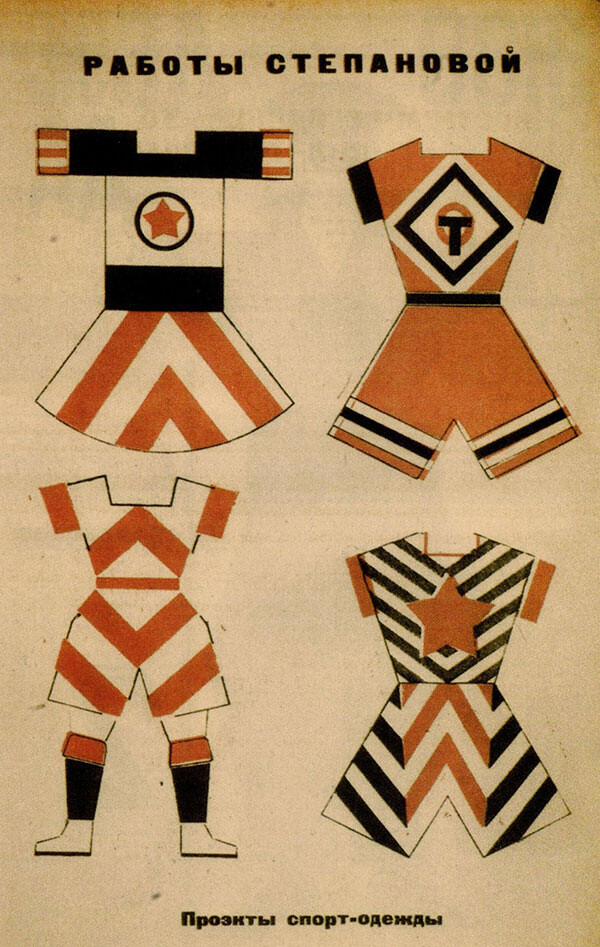

Varvara Stepanova, designs for sports clothes, 1923.
In the comradely relation between the revolutionary human and the revolutionary constructivist/productivist object, neither would remain the same, as their sympoietic relationship would synthesize into a new shared subjectivity, the outcome of which was yet to be known. This Bolshevik heritage, as Jodi Dean observes, “link[s] comradeship to a future characterized by equality and belonging, by a love and respect between equals so great that it can’t be contained in human relations but spans to include insects and galaxies (bees and stars) and objects themselves.”28 For a propaganda art of hyperempathy, there are no “dead planets,” but living worlds of comradely constellations and construct families yet to be embraced. Or, as Zdenka Badonivac phrases it: “in the end, comradeship must include everyone.”29
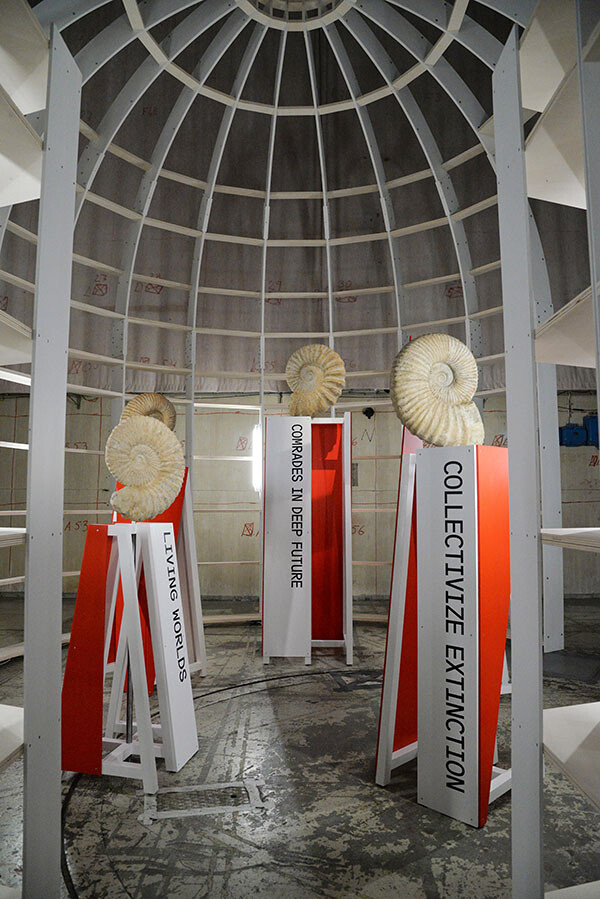

Assembly of neo-constructivist ammonites in Jonas Staal, Interplanetary Species Society, 2019. Photo courtesy of the artist.
Octavia Butler drafted a possible art of hyperempathy in relation to objecthood in her Patternist series. In Mind of My Mind (1977), a member of the telepathic Patternist society named Jan develops the ability to channel the accumulation of human experiences tied to objects. An ancient fragment from a jar made 6,500 years ago in a Neolithic village can evoke, through Jan, the experience of the life of the woman who made it.30 Through the nonhuman jar, past human subjectivities remain part of a living world. In Patternmaster (1976), this telepathic art is refined even further, as artist-Patternists have gained the ability to lift impressions from objects and transfer them to other objects, creating new forms of human-object mutation and coexistence through space and time.31
Hyperempathic practices of nonhuman comradeship also play a key role in the history and present-day practices of cosmism. Originating from the work of Nikolai Federov at the end of the nineteenth century, cosmism combined socialist theory and its technological and scientific potentials with metaphysical religious components, including those of the Russian Orthodox Church.32 Cosmists redefined earth as a spaceship, researched the influence of the sun on leftist uprisings, and demanded the resurrection of the dead: life on earth was to be understood as part of a larger cosmic assembly. As Boris Groys writes: “The communist society of immortals will also be ‘interplanetary,’ that is, it will occupy the entire space of the cosmos.”33 Whereas constructivism and productivism approached nonhuman comradeship and interplanetarianism through a radical and total rejection of the past, cosmism emphasized the radical and total inclusion and equality of timescales: from deep past to deep future.
Although cosmism, like many other revolutionary cultural movements in Russia, was crushed in the Stalinist era, contemporary artists like Anton Vidokle have placed its heritage in a contemporary context. In his 2019 film Citizens of the Cosmos, Vidokle translates the writings on bioscosmism by Alexander Svyatogor from 1922—“Biocosmist society encompasses the whole world and is interplanetary”34—into a series of choreographies, in which humans assemble in shrines, forests, and industrial gas plants in preparation for eternal life and interplanetary citizenship. While the demand for eternal life would have to be enabled by technological means, in Vidokle’s film nonhuman comrades form crucial enablers as well: tombstones are not merely markers of commemoration but form communicative tools with the dead, and bamboo forests are the sites of preparatory resurrection. Driven by a hyperempathic demand against the exclusion of those that lived before us—without the dead resurrected, communism can never be completed—various nonhuman comrades become implicated in defining the cosmist polity.
4. Emancipatory Biospheres
Earlier I referenced Haraway’s proposal for a propaganda practice that, in her words, aims at “collecting each other up.” In the art of hyperempathy, it is the comradely object that “collects up” the human to remain a constitutive part of the world. Haraway further proposes a propaganda that tells truths with “certain kinds of tonalities.” In the case of the comradely object, these tonalities are the resonances that move through such objects across deep time. The literary social experiment, or the cinematic one in the case of Vidokle’s work, enables imaginative models for more-than-human comradeship across coexisting scales of time and space, from interplanetarianism to intra-planetarianism.
Through these extremely diverse landmarks of emancipatory science and cosmic fiction, the beginnings of a propaganda art of hyperempathy can be articulated. We could describe these experiments as “emancipatory biospheres,” for they are sketches of models and infrastructures that allow us to imagine new forms of organizing, shaping, and recognizing life. These are not the corporatist and nationalist biospheres of occupation and extraction exemplified by alt-right propagandist Steve Bannon’s directorship over the Biosphere 2 facility in Arizona—an exercise in world-building correlated with the terrifying alt-right biosphere in which we find ourselves today.35 Instead, they are emancipatory biospheres conceived through a propaganda art of hyperempathy, aiming to imagine and train expanded practices of comradeship that go beyond, but that are also deeply rooted in, the terrestrial—from proletarian object to proletarian plant.
It is no coincidence that many central figures occupying alternative biospheres in various emancipatory fictions have been gardeners. The gardener not only cares for nonhuman subjectivities, but in doing so performs comradeship through reciprocity. In Douglas Trumbull’s 1972 film Silent Running, botanist Freeman Lowell cares for a variety of plants placed in geodesic domes attached to the spaceship Valley Forge. When he receives an order to destroy the biospheres, he asks the robots he has befriended on the ship for help in ridding himself of his human crewmates and protecting his comradely nonhuman plants. Ultimately, Lowell sacrifices his own life to save the biosphere, which remains in the care of his comrade, robot Louie.
In Kim Stanley Robinson’s 1992 book Red Mars, biologist Hiroko Ai uses the garden aboard the spaceship Ares to pre-organize an alternative autonomist community to lead a future revolution for the independence of Mars, free from political and corporate interference from earth. And in Claire Denis’s film High Life (2018), gardener Tcherny—one of several inmates sent on a deadly mission to explore black holes—buries himself alive in the earth of the spaceship’s biosphere. In the first example, Lowell engages in comradely sacrifice in solidarity with the robot-plant construct family that will continue the collective work of reciprocal care in outer space. In the second, Hiroko turns the biosphere into a training ground of a future comradeship that will self-govern Mars. Finally, Tcherny literally disintegrates his living body into living soil, becoming comrade by turning compost.
The word “propaganda” originates from biology, literally referring to the reproduction and duplication—the propagation—of plants and animals.36 In this time of catastrophe on earth and corporate and nationalist schemes to export that very same catastrophe to other living worlds, Haraway’s rethinking of propaganda offers a precondition for collective survival and the perseverance of new socialist forms of living. Neo-constructivist, cosmist, and assemblist training camps and biospheres: these are the terms for a morphological vocabulary of a hyperempathic propaganda art that makes living worlds of comradeship in deep past, deep present, and deep future imaginable and realizable.
Nicky Woolf, “SpaceX founder Elon Musk plans to get humans to Mars in six years,” The Guardian, September 28, 2016 →.
Bob Jessop, The State: Past, Present, Future (Polity Press, 2016), 49.
Alexander Bogdanov, Red Star: The First Bolshevik Utopia, trans. Charles Rougle (Indiana University Press, 1984), 77.
Kim Stanley Robinson famously picks up on Red Star in the first part of his Mars Trilogy, in which a descendent of Bogdanov—Arkady Bogdanov—joins a mission to establish permanent human presence on Mars, and inspires an independent movement known as “Bogdanovism,” structured on socio-architectural theories for communalist living. Kim Stanley Robinson, Red Mars (Harper Voyager, 2009).
Frans von der Dunk, “Van wie is de maan?,” in Bik van der Pol, NG-1991-4-25 (Sternberg Press, 2007), 129–34.
As Eva Díaz points out in her overview of what she calls the artistic “alt-sciences” (not to be confused with the alt-right), “New Spacers like Musk and Bezos treat outer space, ostensibly free of indigenous peoples, as a new frontier exempt from the exploitation that characterized earlier colonial projects.” Eva Díaz, “We Are All Aliens,” e-flux journal no. 91 (May 2018) →.
For a historical view of US space imperialism and its critics leading up to Trump’s declaration of Space Force, see Felicity D. Scott, “Self-Government on the High Frontier,” in Futurity Report, eds. Eric C. H. de Bruyn and Sven Lütticken (Sternberg Press, 2019), 133–50.
Bruno Latour, Down to Earth: Politics in the New Climatic Regime (Polity, 2018), 54.
Ursula K. Le Guin, The Dispossessed (Harper Voyager, 2011), 76.
New World Academy Reader #5: Stateless Democracy, eds. Dilar Dirik Jonas Staal (BAK, basis voor actuele kunst, 2015).
Le Guin, The Dispossessed, 301.
See Bruno Latour’s lecture “A Tale of Seven Planets – An Exercise in Gaiapolitics,” Senior Loeb Scholar Lecture, Harvard University Graduate School of Design, October 16, 2018 →.
John Jordan, “For the Love of Winning: An Open Letter to Extinction Rebellion,” ZAD FOR EVER, May 3, 2019 →.
Octavia E. Butler, Lilith’s Brood (Grand Central Publishing, 2007), 442. See also Antonia Majaca and Luciana Parisi, “The Incomputable and Instrumental Possibility,” e-flux journal no. 77, November 2016 →.
From the opening statements of Anjalika Sagar and Kodwo Eshun at their exhibition “Xenogenesis,” Van Abbemuseum, Eindhoven, May 25, 2019. See also Xenogenesis, ed. Teresa Cos Rebollo (Van Abbemuseum, 2019).
Octavia E. Butler, Parable of the Sower (Grand Central Publishing, 2007), 11-12.
Butler, Parable of the Sower, 222.
Octavia E. Butler, Parable of the Talents (Grand Central Publishing, 2007), 325.
I take the verb “guesting” from iLiana Fokianaki’s assembly “On Guesting,” Roaming Assembly #15, Dutch Art Institute (DAI), Arnhem, September 23, 2018.
Larry McCaffery and Jim McMenamin, “An Interview with Octavia E. Butler, 1988,” in Conversations with Octavia Butler, ed. Consuela Francis (University Press of Mississippi, 2010), 26.
Judith Butler, Notes Towards a Performative Theory of Assembly (Harvard University Press, 2015). See also my essay “Assemblism,” e-flux journal no. 80, March 2017 →.
Donna Haraway, Staying With the Trouble: Making Kin in the Chthulucene (Duke University Press, 2016), 58.
Haraway, Staying With the Trouble, 101.
Haraway, Staying With the Trouble, 102–03.
Transcribed from a lecture by Donna Haraway, Stedelijk Museum Amsterdam, March 25, 2017 →.
Christina Kiaer, Imagine No Possessions: The Socialist Objects of Russian Constructivism (MIT Press, 2005), 34.
Kiaer, Imagine No Possessions, 46.
Jodi Dean, “Four Theses on the Comrade,” e-flux journal no. 86, November 2017 →.
To which Dean would probably add, everyone on the same side. Zdenka Badonivac, Comradeship: Curating, Art, And Politics in Post-Socialist Europe (Independent Curators International, 2019), 34.
Octavia E. Butler, Seed to Harvest (Grand Central Publishing, 2007), 410.
Butler, Seed to Harvest, 641.
See “Russian Cosmism,” special issue, e-flux journal no. 88, February 2019 →, which followed the exhibition and conference program “Art Without Death: Russian Cosmism” at HKW, Berlin, September 1–October 3, 2017.
Russian Cosmism, ed. Boris Groys (e-flux and MIT Press, 2018), 9.
Alexander Svyatogor, “The Doctrine of the Fathers and Anarchism-Biocosmism,” in Russian Cosmism, 77.
Bannon was CEO of the Biosphere 2 Earth System Science Research Facility in Oracle, Arizona, from 1993-95. The futuristic architecture spanned 1.27 hectares and is the largest closed ecological system ever created. Bannon would further pursue his fascination with closed-system technologies through the massive multiplayer online role-playing game World of Warcraft. See Jonas Staal, Steve Bannon: A Propaganda Retrospective (Het Nieuwe Instituut, 2018).
Erwin W. Fellows, “Propaganda: History of a Word,” American Speech 34, no. 3 (October 1959), 182.
Category
Subject
An earlier version of this essay was presented during the conference “Life Choreographies: Infrastructures for a Livable Life #1,” on June 4, 2019 at the Public Art Agency in Stockholm. I thank iLiana Fokianaki and Elvia Wilk for their editorial support in writing this essay, and Edi Muka for our collaborative work on the alternative biosphere in the context of his “Choreographies of the Social.” And of course, thank you to Sven Lütticken for our Athens dialogues on the emancipatory biosphere, as well as the contributors to the “Interplanetary Species Society Assembly” that took place on August 24, 2019 in Stockholm.










